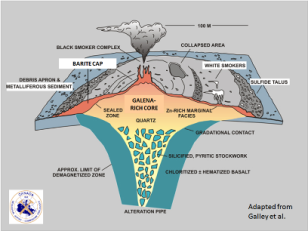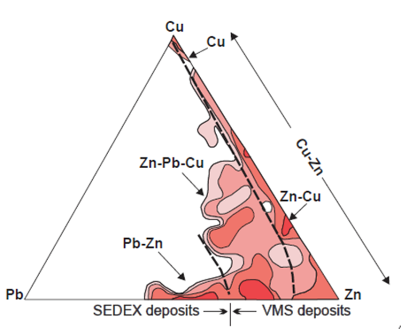Hydrothermal barite
Hydrothermal barites are confined to rift basins, likely because of higher heat flow. In addition to the barite, it is common to find enrichment in heavy metals such as lead and zinc in this setting. We divide rifts into two types based on underlying crust: continental and oceanic. Modern occurrences of hydrothermal barite are known only from the oceanic setting, which can be either a mid-ocean ridge or a back-arc spreading center, whereas most ancient lead-zinc-barium deposits belong to the continental category.
Modern rift-related deposits of Pb and Zn occur on many mid-ocean ridges, either bare ridges or those with significant sediment cover. In the latter category are the Guaymas Basin in the Gulf of California and Escanaba Trough on the Juan de Fuca plate off the Pacific northwest coast (see Modern Barite Occurrences). Barite chimneys are a prominent part of several of these. In the figure below we show a typical volcanic-hosted deposit with a capping of barite.
Shale-hosted deposits, often referred to as sedimentary-exhalative or sedex deposits, have many similarities to the volcanic-hosted category. One difference is they tend to be much lower in Cu and higher in Pb, a reflection of greater involvement of continental crust in the shale-hosted deposits:
Source (both diagrams): Galley et al. (2007)
About 75 % of Phanerozoic sediment-hosted deposits include an appreciable barite component. A prominent example is Red Dog. See also the Geological Survey of Canada's ore deposit description for this category in Goodfellow and Lydon (2007).
Ore Deposits Home |
Barite references |
Site Map |
|---|

